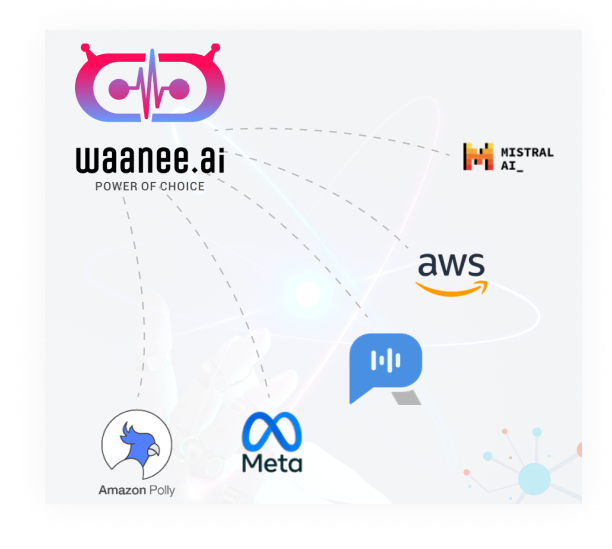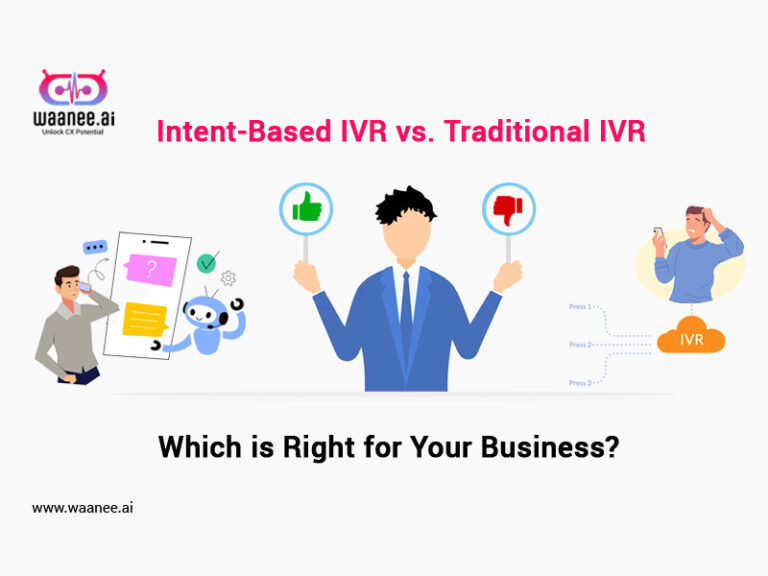
-
Waanee AI Labs
View All »

Get The Latest
Step-by-Step Guide to Migrating from Legacy IVR to Agentic IVR
Read More »How AI-Powered IVR Personalizes Customer Journeys in Real Time
Read More »Why Static IVR Menus No Longer Work in the Age of AI
Read More » - Blog
Intent-Based IVR vs. Traditional IVR: Which is Right for Your Business?
Posted by Vishal Vanwari, on 14 Oct, 2025 07:12 AM

Your phone system is often the first point of contact a customer has with your business. That first impression can either set the stage for a great relationship or start things off with frustration. For years, Interactive Voice Response (IVR) systems have been the standard for routing calls. You know the drill: “Press 1 for sales, Press 2 for support.” But what if there was a smarter, more intuitive way?
Enter intent-based IVR. This advanced technology is changing how businesses handle customer calls, moving beyond rigid menus to understand what a customer actually wants. In this post, we’ll explore the differences between traditional and intent-based systems. We’ll cover the benefits of intent-based IVR and help you decide which is the right choice for your company.
Traditional IVR: The Familiar Menu System
A traditional IVR operates on a simple, structured logic. It presents callers with a limited menu of options, and they use their phone’s keypad (Dual-Tone Multi-Frequency or DTMF) to navigate. For example, a caller might press “1” for account information, then “3” to hear their current balance.
This system is straightforward and has served businesses for decades. It’s predictable and can be effective for simple, high-volume inquiries. However, its rigidity is also its greatest weakness. If a customer’s issue doesn’t neatly fit into one of the pre-defined categories, they are forced to guess, listen to the menu again, or “zero out” to speak with an agent, often feeling annoyed before the conversation even begins.
For a small business with very few departments and simple customer needs, a traditional IVR can still be a cost-effective solution. It handles basic call routing without the need for complex setup.
The Evolution: Understanding Intent-Based IVR
Intent-based IVR represents a major leap forward. Instead of a rigid menu, it uses Natural Language Understanding (NLU) and Artificial Intelligence (AI) to understand the purpose of the call. It greets the caller with an open-ended question, such as, “How can I help you today?”
The caller then responds in their own words:
- “I need to check the status of my recent order.”
- “I want to pay my bill.”
- “My internet is down and I need help.”
The AI analyzes the caller’s speech, identifies their intent, and routes them directly to the right department or provides the information they need without navigating a complex phone tree. It’s like having a virtual assistant who understands human conversation.
Benefits of Intent-Based IVR
Choosing the right technology can transform your customer experience. The benefits of intent-based IVR go far beyond simply routing calls; they impact efficiency, customer satisfaction, and your bottom line.
Improved Customer Experience
The most significant advantage is a dramatic improvement in customer satisfaction. Callers can state their needs naturally instead of listening to a long list of irrelevant options. This reduces frustration and call duration, showing customers that you value their time. Getting to the right solution faster creates a positive and modern service experience.
Increased First-Contact Resolution
By accurately understanding a caller’s intent from the start, the system can route them to the agent or self-service option best equipped to handle their specific issue. This significantly increases the chances that the problem is solved on the first try. Higher first-contact resolution rates mean happier customers and a more efficient support team.
Enhanced Operational Efficiency
Intent-based systems streamline your call center operations. Agents spend less time transferring calls and more time resolving actual issues. The system can also automate routine queries, like checking an account balance or order status, freeing up your human agents to focus on more complex, high-value interactions.
Valuable Data and Insights
Every interaction with your intent-based IVR is a data point. The system collects information on why customers are calling, tracking common issues, and identifying emerging trends. This insight is invaluable for improving your products, services, and overall customer journey. You can learn what your customers truly need, not just which menu option they selected.
Intent-Based IVR vs. Traditional for Small Business: A Comparison
When you’re a small business, every investment counts. The choice between these two systems often comes down to balancing cost, functionality, and future growth.
Feature | Traditional IVR | Intent-Based IVR |
User Interaction | Press-button (DTMF) menus. | Conversational, voice-driven commands. |
Flexibility | Rigid and structured. Hard to update. | Dynamic and adaptable. Learns over time. |
Customer Experience | Can be frustrating and time-consuming. | Fast, intuitive, and personalized. |
Call Routing | Based on menu selection. | Based on caller’s stated intent. |
Setup Cost | Generally lower initial cost. | Higher initial setup and investment. |
Data Insights | Limited to menu path data. | Rich data on customer intent and needs. |
Ideal For | Very simple, low-variance call flows. | Businesses focused on CX and scalability. |
For a small business just starting out, a traditional IVR might seem like the logical choice due to its lower cost. However, a business that anticipates growth or wants to build a brand around excellent customer service should seriously consider the long-term value of an intent-based system. An intent-based IVR can give a small business a competitive edge, helping it operate with the efficiency and polish of a larger enterprise.
Choosing IVR for Business: How to Make the Right Decision
Making the right choice depends on your specific business needs, budget, and long-term goals. Ask yourself these questions to guide your decision-making process.
- What is the primary reason customers call you?
If 90% of your calls are for one or two simple reasons (e.g., “What are your hours?”), a traditional IVR might suffice. If your call reasons are varied and complex, an intent-based system will provide a much better experience. - How important is customer experience to your brand?
If you compete on service, an intent-based IVR is a powerful tool to differentiate your brand. A seamless, modern phone experience tells customers you are forward-thinking and value their time. - What are your plans for growth?
A traditional IVR can become a bottleneck as your business grows and your customer needs become more diverse. An intent-based system is built to scale, adapting to new products, services, and customer inquiries without needing a complete overhaul. - Do you want to leverage data to improve your business?
If you want to understand the “why” behind your customer calls, only an intent-based IVR can provide those rich, conversational insights. This data can inform everything from marketing to product development.
The Future is Conversational
While traditional IVR systems still have a place, their limitations are becoming more apparent in a world where customers expect fast, personalized service. The move toward conversational AI is clear, and intent-based IVR is at the forefront of this shift in customer communications.
By understanding what customers want and routing them effectively, intent-based IVR doesn’t just manage calls—it builds better customer relationships. It transforms a potentially frustrating touchpoint into a positive, efficient interaction. For businesses of all sizes looking to elevate their customer experience and future-proof their operations, the choice is becoming increasingly clear.
Revolutionize CX
with AI power
Delivers personalized interactions and immediate, data-driven solutions powered by AI, transforming customer experiences.

We use cookies!
We use cookies to ensure that we give you the best experience on our website.
By continuing to use this site, you accept our use of cookies. Learn more
 Recruit Industries Agents
Recruit Industries Agents Build Your Agent
Build Your Agent Improve Self Service
Improve Self Service Employee Experience
Employee Experience Sales and Cross Sales
Sales and Cross Sales Calling Script
Calling Script Integration & APIs
Integration & APIs Auto Summarization
Auto Summarization Conversational Intelligence
Conversational Intelligence Sentiment Analytics
Sentiment Analytics Auto QA
Auto QA Net Promoter Score
Net Promoter Score